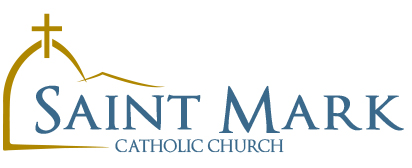History
St. Mark Catholic Church has been the spiritual home to Catholic people and families on the West Bluff of Peoria for over 100 years.
In 1891 the parish of St. Mark’s had its beginning in a small wood frame church at the corner of College Avenue and Underhill Street. This was a temporary structure used during the construction of the permanent church built by Father Francis James O’Reilly, who had been selected by Bishop John Lancaster Spalding as the first pastor at St. Mark’s, the third parish in the Peoria Diocese.
Father O’Reilly had an established reputation as a successful “builder” and he proved to be a wise choice. Just eleven months after his arrival on the West Bluff, the church was dedicated on July 12, 1891. And Father O’Reilly did it all for a figure estimated to be between $25,000 and $30,000!
It was Father O’Reilly’s successor, Father James J. Shannon, who was responsible for the original parish school, a two-story building built directly behind the church in 1897, the same year nearby Bradley University opened its doors. It was not until 1911 that the convent was completed, due to the efforts of Father John J. Burke, who served as third pastor from 1910 until 1940. He was also responsible for enlarging the church and for founding St. Mark’s Hall, a residence for young working women.
The “new” parish was growing so rapidly that in 1920 an enlargement was a necessity. It’s interesting to note that the contractor for the renovations and addition was Charles Wall, the son of the original builder. His father might have been surprised at the elegance of the high altar and chancel communion rail of carrara marble, the cost to expand the church which was twice that of the original construction.
The Peoria Journal Transcript described it as “one of the largest and most beautiful churches in the diocese with its new pews, terazzo marble floors, and three beautiful Gothic marble altars”.
The original portion of the school was erected in 1922 and 1923, also during Father Burke’s pastorate. The dedication was not until 1924 because construction was halted when pledges for the $100,000 needed to complete the work flagged. It was Father Burke’s decision to stop the work until parishioners honored their commitments, reminding them that if they found it difficult to meet their original pledges, they would have a hard time maintaining the school once it was completed.
Father Burke donned the purple robes of the Monsignorate in 1931 and continued his work at St. Mark’s until 1941 when he retired at age 84.
In March of 1941, Monsignor Burke was succeeded by Father James M. Fitzgerald, known affectionately as Father Fitz. Apparently his flamboyant personality was in sharp contrast to the more sedate Monsignor Burke. Under this leadership, the parish continued to grow. In 1953 the east wing was added to the church at a cost of a quarter of a million dollars. A new rectory followed in 1956 and the new convent six years later. In 1962 an addition was added to the school due to an enrollment of over 700 students.
Father Fitzgerald was deeply involved with the school children and was a constant presence at their activities, so it is not surprising that he endowed scholarships to four graduates each year. This generous tradition continues to the present time.
Father Fitz’s unselfishness extended to many other areas at St. Mark’s and in the years succeeding his death, the Father James Fitzgerald Memorial has provided funds for parish projects as well as many local charities.
Following Father Fitzgerald’s death on St. Patrick’s Day in 1973, Father John Dietzen became the fifth pastor of St. Mark and served from 1973 to 1983.
In 1975, following the Second Vatican Council, the church was remodeled and redecorated to conform to the new liturgical requirements. Much of the marble was removed, orange carpeting was installed, and a large wooden altar was constructed and placed close to the pews. Tragically, only six weeks after the remodeling was completed, both sacristies were virtually destroyed by fire, which caused extensive smoke damage throughout the building. It was restored shortly afterwards.
Father Dietzen commissioned the St. Mark’s Statue in the fall of 1978. The statue is at the corner of Bradley Avenue and University Street. More info on statue
Succeeding Father Dietzen was Father Thomas Murphy (1983-88) who was instrumental in adopting two parishes in Haiti, as well as setting up a group home for the developmentally disabled. The parish food pantry which began during Father Murphy’s pastorate continues to the present, now in conjunction with Westminster Presbyterian Church. Monsignors Albert Hallin (1988) and James Campbell (1988-90) served as Pastors until Father Robert Schladen (1990-98) was appointed.
Father Schladen left his post as Executive Director for Priest Personnel under Bishop O’Rourke to become pastor of St. Mark’s in 1990. He implemented and enthusiastically supported the Renew Program, a community building effort centered around the Lord Jesus Christ. He served as pastor during the 100th anniversary of the parish.
In 1998, Father Benjamin Reese became the tenth Pastor of St. Mark Parish. Father Reese emphasized family faith formation, and renewed devotion to Jesus in the Eucharist and to the Blessed Mother. He developed long range goals in 2000 that led to the renovation of our historic church. He, along with Father Francis Gallagher, worked to transform St. Mark’s to its original beauty. Their work resulted in the church becoming a Diocesan Shrine to Fra Angelico.
Father Donald Henderson joined us for one year, from 2005-2006; and Father Brian Herlocker served as Associate Pastor from 2006-2008, when he was made Pastor of Immaculate Conception Catholic Church in Monmouth, Illinois. Father Charles Klamut was named pastor at St. Mark’s in 2006, and served until June 2011, when he was appointed Assistant Chaplain at the St. John Newman Center-University of Illinois at Champaign-Urbana. Ordained in 1999 after attending Franciscan University in Steubenville, Ohio. He served as Associate Pastor at St. Philomena Parish from 1999-2002, and as Chaplin of Peoria Notre Dame High School from 2002-2008. Father Klamut, who embraced the diversity of his parishioners, made St. Mark’s a Stewardship Parish. A music lover, singer, songwriter, and guitar player, Father Klamut continues to share his music with everyone around him.
St. Mark’s pastor since 2011, Monsignor Brian K. Brownsey, was born and raised in Streator, IL. Ordained a priest of the Catholic Diocese of Peoria on May 25, 1996, Monsignor Brownsey has served parishes and schools throughout the Diocese, including Sacred Heart Church (Moline), Allerman High School (Rock Island), St. Mary’s (Utica), Marquette High School (Ottawa), and St. Peter’s (Peoria). In 2008, he became the Director of the St. Joseph Newman Center and remains the Director of Vocations for the Diocese.
Under Monsignor Brownsey, St. Mark’s has seamlessly integrated the Catholic students at Bradley University and the St. Joseph Newman Center into parish life. Many of these students are permanent parishioners and they are at Holy Mass on Tuesday mornings and Sunday evening. They lead the music at the Friday morning School Mass; and help with other ministries, as well. As Monsignor Brownsey notes: “I prefer to think of us as the parish that serves the entire parish community – old established families, new families making their homes in West Peoria, the small children, retired people, and the college students who bless us with their presence.”



